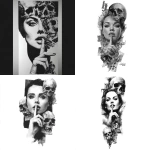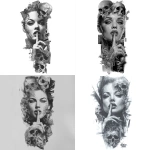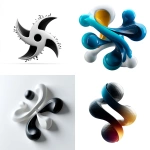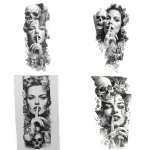Explore the Best AI Image Gallery

Pixels on Skin: How AI-Generated Images are Reshaping Design
The world of design is undergoing a seismic shift, driven by the emergence of artificial intelligence (AI) and its ability to generate stunningly realistic images. No longer confined to the realm of science fiction, AI image generation tools are now empowering designers, artists, and businesses with unprecedented creative possibilities. This transformative technology is blurring the lines between human and machine creativity, prompting a fascinating exploration of its impact on the design industry.
A New Creative Frontier: Applications Across Design Disciplines
AI image generators are proving to be versatile tools, finding applications across a wide spectrum of design disciplines:
- Branding and Marketing: AI can assist in creating unique logos, brand identities, and marketing materials tailored to specific target audiences. Imagine generating countless variations of a logo within minutes, exploring different styles and aesthetics with ease.
- Web and UI/UX Design: AI can generate website layouts, interface elements, and user experience mockups, accelerating the design process and enabling designers to experiment with innovative concepts.
- Product Design: AI can help visualize product concepts, generate variations based on specific parameters, and create realistic renders for presentations and marketing materials. This is particularly valuable in industries like furniture, fashion, and consumer electronics.
- Visual Storytelling: AI can assist in creating compelling illustrations, comic panels, and storyboards for books, films, and games, bringing narratives to life with unique visuals.
The Ethical Considerations: Navigating Uncharted Territory
While the potential of AI image generation is immense, it also raises several ethical considerations that need careful attention:
- Copyright and Ownership: Who owns the copyright to AI-generated images? Is it the user who provides the prompts, the developers of the AI tool, or the AI itself? This legal gray area requires further clarification.
- Bias and Representation: AI algorithms are trained on vast datasets, which may contain biases that reflect societal stereotypes. It is crucial to ensure that AI-generated images promote diversity, inclusivity, and avoid perpetuating harmful representations.
- Transparency and Accountability: The decision-making processes of AI models can be complex and opaque. It is important to strive for transparency in how AI generates images and establish clear lines of accountability for any potential misuse or harm.
Future Trends: The Evolving Landscape of AI Image Generation
The field of AI image generation is rapidly evolving, with continuous advancements shaping its future trajectory:
- Increased Personalization: AI will empower individuals to create highly personalized images tailored to their specific needs and preferences.
- Enhanced Realism and Detail: AI models will continue to produce increasingly realistic and detailed images, blurring the lines between the virtual and the real.
- Integration with Other Technologies: AI image generation will seamlessly integrate with other technologies like VR/AR, robotics, and the metaverse, creating immersive and interactive experiences.
Conclusion
AI-generated images are revolutionizing the design landscape, offering a plethora of creative possibilities while raising important ethical considerations. As this technology continues to evolve, it is essential for designers, artists, and policymakers to engage in thoughtful discussions and collaborations to harness its full potential responsibly. The future of design lies at the intersection of human ingenuity and artificial intelligence, where pixels on skin will become a canvas for innovation and imagination.


](https://images.ai-img.art/thumbnails/150/24610c8978ce6b4f1ced8639b434482871adb07e38af8b90cd535f2533bf18cc.webp)











](https://images.ai-img.art/thumbnails/150/9127f72c6be19d533c26ac476f4d216cd89a6a2d7c351333489a3eff30c3ec5a.webp)


](https://images.ai-img.art/thumbnails/150/336026613fd234b8d6908fe18ecc09b2b2ecf7b8dfe294742041c9862dc499c1.webp)














](https://images.ai-img.art/thumbnails/150/85464d88f1d4314cd042a02a6f41440fc3b4343db529794cbe8e6836fdadf409.webp)








](https://images.ai-img.art/thumbnails/150/b90a5f332cb5d8f02116934e13abd20233e0eeb2368274dbdffaa2e281e4dff5.webp)

](https://images.ai-img.art/thumbnails/150/4a4f2a16da94ebadad64aeb3b0fb4e64d426431f1d651cc4929142c728fe85b7.webp)


](https://images.ai-img.art/thumbnails/150/d29fcfc8037938184a641f7980e1102e24a6e82088bc465886d26ffe5bb006c7.webp)


](https://images.ai-img.art/thumbnails/150/37f115f2fa75765b87e6d3e2c9f1b0a80a6a46efa8b864a05278c7fc0a0a62e7.webp)